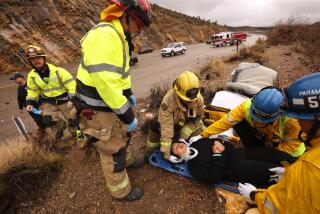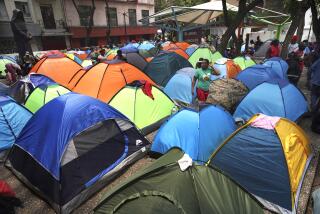West Germans, Trained Dogs Lead International Rescue Effort
MEXICO CITY — Lutger Schauren, a surgical mask covering his face, peered up at the mound of rubble, paused for a moment, then gave the command.
His German shepherd, Arco, surged forward toward the small opening at the top of the debris, with Schauren scrambling close behind. In seconds, they were out of sight, working their way into a pocket where rescue workers thought there might still be someone alive.
The two of them, along with other rescue workers from West Germany, had played out this scene many times Monday. They, along with hundreds of workers from all over the world, have come here to help in the wake of last Thursday’s earthquake, which buried thousands of people under tons of rubble.
The West Germans, along with others working with trained dogs and sensitive hearing devices to detect life under the debris, were racing against the clock. By Monday, those who were alive but still buried had been there for four days, and the Mexican government was faced with the grim task of deciding how long the careful digging could continue before the risk of spreading disease became too great.
Minutes ticked by as other West German civil defense workers waited below. Then Schauren and Arco reemerged at the opening and slid down the mound of concrete chunks.
“Nothing,” Schauren said.
The West Germans walked on to another fallen building to try again, while other foreign workers encountered similar scenes in other parts of the city.
As the days go by, more foreigners can be found at the scenes of destruction around the city. They came wearing everything from the flowing orange robes of the Anadas Margea Universal Relief Team from Denver to U.S. Forest Service uniforms to Israeli flight suits.
Cubans are here, as are French, British and Japanese. So many American groups have arrived that the U.S. Embassy does not have an accurate count of their numbers. The Mexican government, deluged by the relief materials flooding into the capital, has adopted an “open skies” policy that allows any airplane to land without clearance.
Among the Americans who have come are demolitions experts, doctors and search-and-rescue units. Two pecan farmers from San Antonio flew here the day after the earthquake to help because they have visited here often and say they feel a special affinity for Mexico. A doctor and four nurses, all burn specialists from Arizona, also flew in to help.
“That type of thing is not unusual,” U.S. Embassy spokesman Vincent Hovanec said. “People have been showing up.”
Official assistance from the U.S. government has been arriving since Saturday, when a search-and-rescue team, four dog handlers and two explosives experts flew in. Since then, aid has included firefighting helicopters, 16 generators, an 18-member damage assessment team, 600 sleeping bags, 600 jackets, cots, chain saws, water storage tanks and 5,000 plastic body bags.
Congress has adopted a resolution asking President Reagan to make $100 million in relief funds available to the Mexican government. And Hovenac said that more aid will be available once the assessment teams determine the most pressing future needs. He said that 1,000 tents, along with thousands of blankets, are being kept on standby in Panama and can be sent immediately.
But in spite of the volume of the supplies arriving and on the way, the most impressive aspect of the international assistance effort is the work of volunteers in the field.
At the capital’s huge Nuevo Leon apartment complex, which collapsed with more than 1,000 people inside, workers from the Swiss Dog Rescue Assn. worked with Florida’s Dade County search-and-rescue unit, looking for survivors inside the maze of concrete and twisted steel.
Trained Barkers
Sabina Stoessel of the Swiss team said that the dogs have been trained to bark excitedly if they find someone alive but to give only a single yelp at the discovery of a corpse. All that could be heard at one point Monday was the latter.
Douglas Jewett, of the Dade County team, emerged from a hole where he had been for an hour. He is an expert at using the “jaws of life” tool often employed to pry people from wrecked automobiles.
Covered with dust, his face showing fatigue, Jewett had lost patience with the bureaucratic requirements of the Mexican government. He said he had needed a separate pass for each of the two places where his team had worked.
“There is no coordination at all,” he said. “We’re not here to rip people off. We’re here to save lives.”
Diane Greene, one of the pecan farmers from San Antonio, sat on a concrete slab nearby. Her partner, William Eicher, is a skilled heavy equipment operator, but he had not been needed for that kind of work, so the two of them had teamed up with the Florida group. Greene said that San Antonio Mayor Henry Cisneros called for volunteers to fly to Mexico City but that they had decided to come ahead on their own.
Longtime Visitors
“We just figured they wouldn’t get off the ground before everyone was dead,” she said. “We’ve been coming in and out of Mexico City for a long time and we felt we should do something.”
There was also Richard Dick, a demolitions specialist with the U.S. Bureau of Mines, who was examining badly damaged buildings that would have to be razed.
There were Jim Boukidis, Bill Hayes and Debbie Finley of the U.S. Forest Service, who were part of a helicopter firefighting unit from Kernville, Calif. That specialty was not needed, so they are helping supervise the use of special concrete-cutting saws.
Early Monday morning, a group from the California Rescue Dog Assn. arrived. They set out for a fallen building after a briefing from a U.S. Embassy official. Among them was Peter Fabrick, a paramedic on the Hoopa Indian reservation in Humboldt County. His dog, Alex, an Australian kelpie, was much smaller than those the Germans and Swiss dog-handlers were using.
“My dog is real agile and small,” Fabrick said. “That may be an asset here.”
More to Read
Sign up for Essential California
The most important California stories and recommendations in your inbox every morning.
You may occasionally receive promotional content from the Los Angeles Times.










